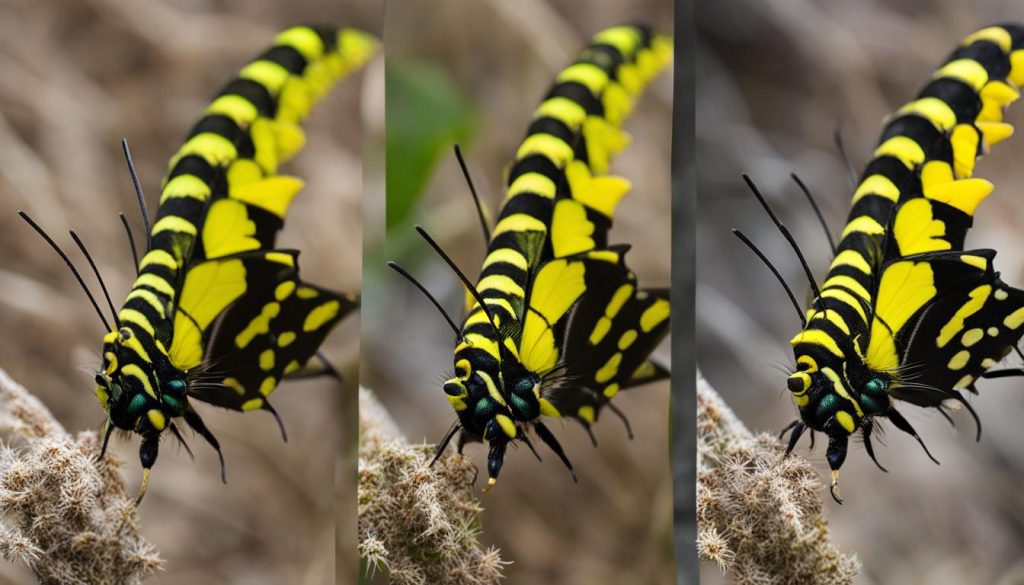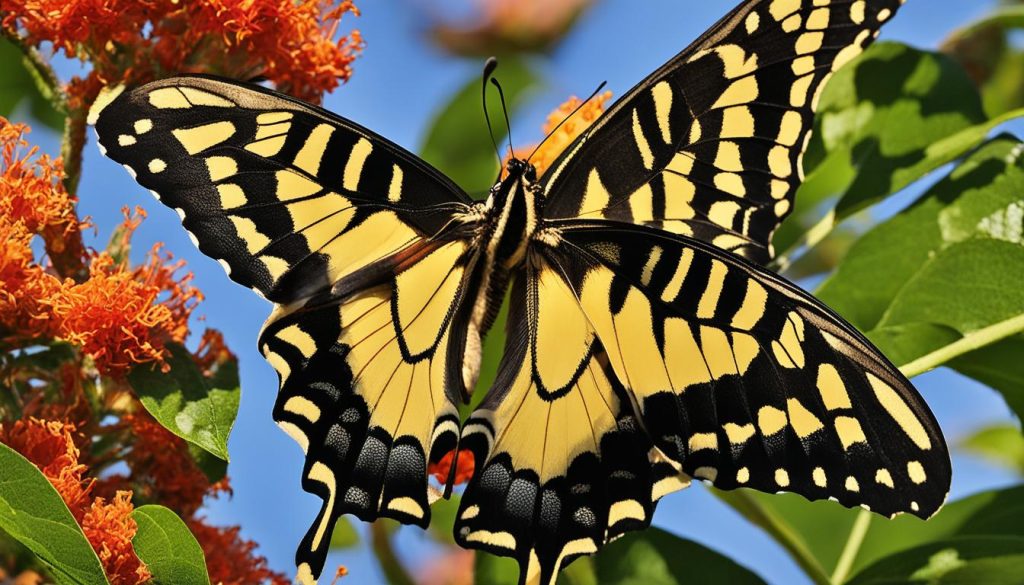The Giant Swallowtail Butterfly (Papilio cresphontes) is a magnificent butterfly species that can be found in the Eastern United States. Unlike monarch butterflies, giant swallowtails lay their eggs on a variety of host plants. Some common host plants for giant swallowtail caterpillars include Ruta Graveolens, Ptelea trifoliata, and Zanthoxylum americanum. It is important to properly identify giant swallowtail caterpillars and provide them with the appropriate care to ensure their successful development.
Key Takeaways:
- Giant swallowtail caterpillars are found in the Eastern United States.
- They lay their eggs on a variety of host plants.
- Identifying and properly caring for giant swallowtail caterpillars is crucial for their successful development.
- Common host plants for giant swallowtail caterpillars include Ruta Graveolens, Ptelea trifoliata, and Zanthoxylum americanum.
- Providing suitable care and host plants will ensure their successful transformation into adult butterflies.
Identifying Giant Swallowtail Caterpillars
When it comes to caterpillar identification, the giant swallowtail caterpillar stands out with its unique features and stages of development. If you are interested in raising giant swallowtail caterpillars, it is essential to be able to identify them correctly and provide them with the care they need to thrive.
Starting from the egg stage, giant swallowtail butterfly eggs are easy to spot. They are typically laid on the surface of green leaves and have a distinct orange-peel color. Once hatched, the caterpillars go through several stages, displaying a range of colorations from bright orange to dark shades.
Giant swallowtail caterpillars have fascinating defense mechanisms to protect themselves from predators. They can mimic the appearance of bird droppings and even snakes, deterring potential threats. Additionally, they possess bright red horns called osmeterium, which emit a pungent odor when the caterpillar feels threatened.
To ensure the successful growth of giant swallowtail caterpillars, it is crucial to protect them from natural enemies and provide them with suitable host plants. These plants serve as a food source and contribute to their healthy development.
“Giant swallowtail caterpillars have fascinating defense mechanisms to protect themselves from predators.”
By understanding the unique characteristics of giant swallowtail caterpillars and their stages of development, you can enhance your experience in raising these magnificent creatures.

Giant Swallowtail Caterpillar Stages:
- Egg stage: Easily identifiable orange-peel colored eggs on green leaves.
- Caterpillar stage: Multiple stages with color variations from orange to dark shades.
- Defense mechanisms: Mimic bird droppings and snakes to deter predators.
- Osmeterium: Red horns emitting a pungent odor when threatened.
Providing the appropriate care and protection for giant swallowtail caterpillars will ensure their successful transformation into beautiful butterflies. The next section will explore the life cycle of giant swallowtail butterflies, shedding light on their fascinating journey from caterpillar to butterfly.
The Life Cycle of Giant Swallowtail Butterflies
The life cycle of giant swallowtail butterflies consists of four stages: egg, caterpillar, chrysalis, and adult butterfly. Understanding each stage is crucial to appreciating the remarkable transformation these butterflies undergo.
Egg Stage
The life cycle begins with the female giant swallowtail butterfly laying her eggs on suitable host plants. The eggs are typically small and can be found on the surface of green leaves. They have a distinctive orange-peel color that allows them to blend in with the foliage and protect them from predators. The eggs hatch within 4 to 10 days, revealing tiny caterpillars ready to embark on their journey.
Caterpillar Stage
Once hatched, the caterpillars start feeding on the host plants. They go through several stages known as instars, shedding their exoskeleton each time they outgrow it. The appearance of the caterpillars changes as they mature, with colors varying from orange to dark shades. Giant swallowtail caterpillars have unique defenses, such as mimicking bird droppings and snakes to deter predators. They also possess red horns called osmeterium, which emit a pungent odor when threatened. This serves as an additional deterrent to potential predators.
Chrysalis Stage
After approximately 3 to 4 weeks of feeding and growing, the caterpillars begin their transformation into adult butterflies. They find a suitable location to form a chrysalis, where they undergo metamorphosis. Inside the chrysalis, the caterpillar’s body breaks down and reorganizes, forming the intricate structures of a butterfly. This stage can last anywhere from 10 to 15 days, depending on environmental conditions.
Adult Butterfly Stage
Finally, the adult giant swallowtail butterfly emerges from the chrysalis. With its wings unfolded, it takes time to dry and harden before taking its first flight. The adult butterfly is a magnificent sight, with its dark brown wings adorned with bright yellow markings, including a large horizontal stripe. These butterflies have a wingspan ranging from 4.0 to 6.0 inches, making them the largest butterflies in North America.
To attract giant swallowtail butterflies to your garden, it is essential to provide suitable host plants. Citrus trees, Hercules Club, Prickly Ash, Wild Lime, and Common Rue are among their preferred host plants. Creating a welcoming environment with these plants can help attract and support the entire life cycle of the giant swallowtail butterflies.
Appearance and Habitat of Giant Swallowtail Butterflies
The Giant Swallowtail Butterflies are truly a sight to behold with their striking coloration. These magnificent creatures have dark brown wings adorned with vibrant yellow markings, including a large horizontal yellow stripe that spans across their wings. This unique color pattern makes them easily recognizable and adds to their beauty. The giant swallowtail butterflies are the largest butterflies in North America, boasting an impressive wingspan ranging from 4.0 to 6.0 inches.
When it comes to their habitat and distribution, giant swallowtail butterflies are commonly found throughout the Eastern United States. They can be spotted in a variety of settings, including wooded areas, meadows, and residential gardens. These butterflies have a wide range and can adapt to different environments, but they are particularly drawn to areas with an abundance of suitable host plants.
Giant Swallowtail Host Plants
Host plants play a crucial role in the life cycle of giant swallowtail butterflies. They serve as the primary food source for the caterpillars, allowing them to grow and develop. Giant swallowtails have specific preferences when it comes to host plants, and providing these plants in your garden can attract these beautiful butterflies.
Here are some of the preferred host plants for giant swallowtails:
- Citrus trees
- Lime
- Hercules Club
- Prickly Ash
- Wild Lime
- Common Rue
By including these host plants in your garden, you can create a welcoming habitat that supports the growth and survival of giant swallowtail butterflies.
Giant Swallowtail Nectar Plants
Giant swallowtail butterflies not only rely on host plants but also seek out nectar plants for nourishment. These plants provide the adult butterflies with the energy they need to fly and reproduce. Including nectar-rich plant varieties in your garden can help attract and sustain giant swallowtails.
Here are some nectar plants that giant swallowtails are particularly fond of:
- Milkweed
- Lantana
- Butterfly bush
- Zinnias
- And more…
By providing a diverse selection of nectar plants, you can create an enticing haven for giant swallowtail butterflies and enjoy their captivating presence in your outdoor space.

| Giant Swallowtail Butterfly Appearance | Habitat and Distribution |
|---|---|
| Dark brown wings with yellow markings, including a large horizontal yellow stripe. | Found throughout the Eastern United States. |
| The largest butterflies in North America, with a wingspan ranging from 4.0 to 6.0 inches. | Typically found in wooded areas and residential gardens. |
Conclusion
Giant swallowtail caterpillars are a wonderful addition to any butterfly garden. By taking care of these remarkable creatures and providing them with the right environment, you can witness their remarkable transformation into beautiful butterflies.
Creating a butterfly garden with a variety of host plants and nectar plants can attract and support the growth of giant swallowtail caterpillars. These caterpillars will thrive on plants like citrus trees, Hercules Club, Prickly Ash, Wild Lime, and Common Rue. As the caterpillars grow, they will form chrysalides and undergo metamorphosis, emerging as stunning butterflies with dark brown wings and striking yellow markings.
Attracting giant swallowtail butterflies to your garden is not only a visual delight but also beneficial for the ecosystem. These butterflies play a vital role in pollination, ensuring the reproduction of various plants. By creating a welcoming habitat, you can encourage the presence of these magnificent creatures and enhance the biodiversity of your outdoor space.
So, if you’re passionate about butterflies and want to create a butterfly haven, caring for giant swallowtail caterpillars and attracting butterflies to your garden is a fantastic way to start. With their unique coloration and impressive wingspan, these butterflies will bring beauty and joy to your outdoor space for years to come.
FAQ
What are some common host plants for giant swallowtail caterpillars?
Some common host plants for giant swallowtail caterpillars include Ruta Graveolens, Ptelea trifoliata, and Zanthoxylum americanum.
How do I identify giant swallowtail caterpillars?
Giant swallowtail caterpillars can be identified by their unique colors, which can vary from orange to dark shades. They also have red horns called osmeterium and can mimic bird droppings or snakes as a defense mechanism.
What is the life cycle of a giant swallowtail butterfly?
The life cycle of a giant swallowtail butterfly consists of four stages: egg, caterpillar, chrysalis, and adult butterfly.
Where can I find giant swallowtail butterflies?
Giant swallowtail butterflies can be found throughout the Eastern United States, typically in wooded areas and residential gardens.
How can I attract giant swallowtail butterflies to my garden?
To attract giant swallowtail butterflies to your garden, provide them with suitable host plants such as citrus trees, Hercules Club, Prickly Ash, Wild Lime, or Common Rue. Additionally, create a welcoming environment with a variety of nectar plants.








